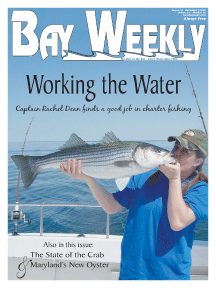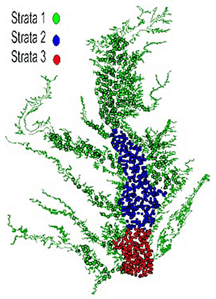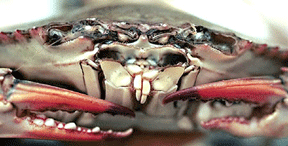
Volume XVII, Issue 35 # August 27 - September 2, 2009 |
 |
The State of the Crab
Blue crabs make tasty measurement of the state of our state
by Sandra Olivetti Martin
You’re listening to the Orioles on the radio when the crab attacks.
In what used to be prime hotdog time and territory, the smooth voice of the announcer is singing the praises of Maryland crab.
Obediently, your appetite rises. Forget the hotdog; crabcake is now your craving. Pulling the strings on the puppet you’ve become is the Maryland Department of Seafood Marketing, a branch of the Maryland Department of Agriculture.
Crabcake and Orioles?
Of course, explains spokeswoman Noreen Eberly. “Crab is the prize seafood in Maryland. Traditionally we love our crab feasts, but a nice, beautiful crabcake or stuffed rockfish — they’re all quintessential Maryland dishes. They define us.”

To Satisfy Our Crab Appetites …
Unlike oysters, which can be happily domesticated, crabs are wild things. They don’t breed well in captivity, and they want to roam. The only way to hold them is to lock them up in a crab pot — a catching pot in the Bay or a cooking pot on your stove.
So if we’re going to feast on Maryland’s signature crustaceans today and pass the tradition — along with the steaming pot — down to our grandchildren, we’ve got to keep a healthy breeding population.
With their hard shells and fierce pinchers, crabs seem perfectly able to manage for themselves. But they’re no match for human appetites.
Crab numbers have been declining significantly, if not steadily, since 1990. From highs in the 800 millions that decade (countered by lows in the 300 millions), highs in this century have reached only the 400 millions (while lows have fallen into the 200 millions).
How do we know?
Crab populations are estimated by two measures: reports of watermen and Maryland Department of Natural Resources’ annual Baywide winter dredge survey.
… Take the Pressure Off Sallies
Nowadays, crab managers think that means keeping more females out of our pots and in the water to produce dynasties of little crabs.
Last year, the well-being of the Atlantic blue crab, Chesapeake Country’s signature seafood, provoked Maryland and Virginia to cooperation on a species that traditionally each state has regulated very differently. Their agreement matters because crabs spend different parts of their life cycle in each state. Females, in particular, migrate down-Bay into Virginia waters to overwinter in the muck.
|
|
 |
![]() In fact, Virginia took the lead in saving female crabs by ending its longstanding winter dredge fishery, which caught primarily females. Both states agreed not only to limit each waterman’s fall catch of females but also to shorten the season on females.
In fact, Virginia took the lead in saving female crabs by ending its longstanding winter dredge fishery, which caught primarily females. Both states agreed not only to limit each waterman’s fall catch of females but also to shorten the season on females.
The goal was a 34 percent reduction Baywide in the female crab harvest.
“It’s made a huge difference,” said Brenda Davis, manager of Maryland’s blue crab program.
Last winter’s dredge survey found a greater density of harvestable crabs than average over the last 18 years. Both males and females were up, but the increase in females was way larger.
“But we still cannot claim success,” Davis said. “It was a first step, because the number of small crabs did not increase — and we wouldn’t have expected it to — because the females saved would spawn this summer.”
A bit of crab biology. Females are capable of producing more than one brood of eggs. But they mate only once in their lives, at their terminal molt.
In visual terms we can all understand, before that terminal molt, the underside apron that reveals a crab’s gender is triangular. After that molt, the apron takes the familiar shape of the capital dome.
In the winter of 2009-’10, however, crab managers are hoping more smaller crabs will turn up in the six-foot-wide Virginia crab dredge fitted with a half-inch nylon mesh liner and towed along the bottom for one minute at a speed of three knots.
And this year, both states have tinkered with their limits to try to make the restrictions fall equally throughout the season and Bay. Maryland’s season for females extends several weeks longer this year, closing in early November.
How’s the Catch?
That’s harder to tell. Watermen’s reports are notoriously unreliable, which makes a guesstimate of the three-month estimate of 11.1 million pounds of crab in the shell, weighed at about 40 pounds to the bushel.
About the same as last year’s, everybody says, and getting better by the day as late summer and autumn bring crab-catching to its best.
Crab-picking plants are humming, according to Joe Brooks of J.M. Clayton Seafood Company in Cambridge, because federal regulations have finally allowed foreign guest workers visas to cross the border from Mexico to take picking jobs on the Eastern Shore.
“We’re thrilled,” Brooks says. “They’re coming back just in time. Otherwise there’d be a devastating effect on the crab-picking industry, and watermen themselves would have no place to sell. They can’t sell them all to the live trade.”
We did commerce in the live trade this weekend, paying $30 a dozen for No. 1s and $18 for No. 2s. As warned, most were light, meaning they hadn’t yet filled out their new shell after recently shedding. Which also means that soft-shell crabs are now abundant. (But when you’re buying soft-shells, remember why you should avoid females.)
On the other hand, “we don’t need every crab to recover the fishery,” advises the state crab program’s Davis. “It’s perfectly good to catch and eat crabs” — as long as we follow the regulations.
Can You Say License-buyback?License-buyback has come into our vocabularies this year, courtesy of Maryland Department of Natural Resources, where what seemed to be a reasonable plan has gone wryly awry. Here’s how it came to be: Crab licenses are controlled by the state, which has licensed about 6,000 fishermen to catch crabs. This year the state decided to buy back as many as possible of the 3,676 limited crab-catcher licenses that allow their holders to set only 50 pots — as opposed to 300 under the full license. The point, according to blue crab program manager Brenda Davis, was to enable her department “to be certain our bushel limits will achieve the reduction in harvest we need.” That’s because bushel limits on females are determined by harvest history. If you had no history, how many should you get to catch? To take 2,000 of those licenses off the water, crab managers came up with what they thought was a win-win plan: a reverse auction, asking crabbers how much they’d sell their license for. Crabbers didn’t see the win in it for them. Only 494 submitted bids, and they ranged from under a hundred dollars to millions. Crabbers, apparently, weren’t willing to let their licenses go. Many said they were holding onto them for a rainy day, and in this bad economy, it’s raining. The department hasn’t given up its goal, but it’s changed its strategy. Based on bids, the buyback price will be $2,260. If few crabbers bite, regulation is promised on inactive licenses, whose holders have no harvest history between 2004 and 2008. –SOM |

